|
FAQs about Marine
Protozoans
Related Articles: Marine Protozoans,
Marine
Microbes, Marine Virology, Marine Mycology, Marine
Bacteria, Phytoplanktonic
Marine Algae, Invertebrates, Marine Plankton, Taxonomy & Biological
Classification
Related FAQs: Marine
Microbes, Marine Virus,
Marine Bacteria, Marine Funguses, Marine Plankton, Phytoplankton, Live
Rock,
|
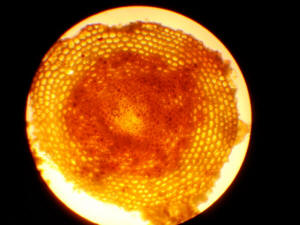 |
|
Snails? 8/23/17
Hi,
<Howsit Ryan?>
My local aquarium shop suggested that I submit a question about some critters in
my tank. The attached images show these "sand-sized" organisms (about 1mm in
diameter) blooming in my tank.
<Neato! These are Foraminiferans! Sign of a healthy system, lack of predators>
They have been there for months and seem benign, or maybe even helpful (eating
algae?), though they do obstruct the view of the tank some. There are thousands
of them in the sand bed, on the rocks, and on the glass.
They move very slowly...as indicated by some time-lapse video. The close-up
photos were taken with a macro lens.
Can you provide any insight? Are they helpful? Harmful? Should I be concerned?
<No concern; are helpful... Enjoy them while you can, as changes in your system
will result in their crashing population wise... other life becoming more
dominant in time>
Thanks!
Ryan
<Thank you for sharing. There's a bunch on the Net (even WWM) re:
https://en.wikipedia.org/wiki/Foraminifera
Bob Fenner>
|
  |
|
Re: Snails? 8/23/17
Excellent. Thanks for the info Bob!
<Welcome Ryan. BobF>
|
|
red macro algae? coral? sponge?
1/16/14
Hi Crew - first, thanks for an extremely useful website - whenever I
have a question that I cannot find an answer to - your site is one of
the few places that offers exactly the right answer.
<Ahh>
I have 60gal reef tank that I have been VERY patient with. I
started it up 9 months ago and just bought my first corals last week.
This was in part as I was fighting a diatom bloom initially, then a
seemingly endless Cyano problem until recently. The major reason
for the Cyano die off/control now, was switching from an algae scrubber
to a properly rated skimmer, and using only foods with low P content.
<Ditto!>
This has helped immensely and I got to the point of being comfortable
putting corals in. Coralline growth has become markedly more
prolific since then too.
<Ah, good>
Now my question is this: while fighting the various plagues (including a
300+ Aiptasia outbreak - thank god for berghia nudis), I noticed a
really pretty hitchhiker on some of my live rock. So this started
growing during a time when even though my kit readings were essentially
non detect, but the presence of Cyano/green hair indicated that I had a
surplus N or P issue. At first I thought it was a type of coral,
and then considered sponges - but then someone on a forum suggested that
it is likely a red macro algae - rhodophyte of some form?
<This is my guess as well (or a Foramiferan)... I didn't see (under
magnification of your photo) any pores/openings... that would be present
in Corals, Poriferans>
It is a soft tissue, plate-like structure that is now roughly the
size of quarter (with about half a quarter "depth" to it).
There is a second larger example growing at the back of my tank, out of
reach of a decent photo - that specimen is roughly two inches wide, an
inch high and an inch deep.
Any thoughts? Is it more likely a red algae? Finally - this
is the important bit: is it good or bad?
<Much more good than bad... mostly as an indicator of healthy conditions
here. Not toxic>
Should I be considering removing it, or if my water chem. is truly coming
around, should this guy just die off/starve anyway? Any thoughts
would be greatly appreciated. It's really pretty and I'd prefer to
keep it if it isn't doing any harm...
http://s29.postimg.org/kxvbnj66v/IMG_0746.jpg
and image attached for good measure too.
Sincerely,
Mark
<Cheers, Bob Fenner>
|
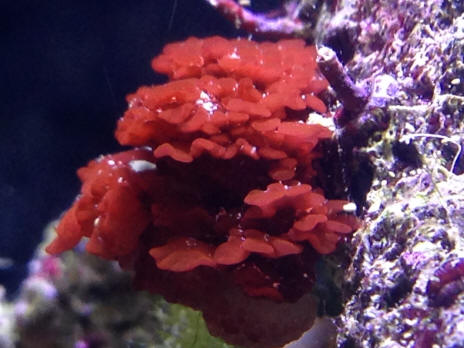 |
Re: red macro algae? coral? sponge?
1/16/14
Well that's good news then! Thank you so much for the speedy and
reassuring response - you guys are the best!
<Ah, welcome Mark. BobF> |
|
Live rock growth 10/28/13
Hello crew!
<Hey Em>
A rock in my 90 gallon reef has recently sprouted a patch of red sticks with
stiff white whiskers. They are quite beautiful and don't seem to be
bothering the mushrooms they are growing in between. Can you help ID?
<Mmm, have seen this before... I believe this is a Foraminiferan... possibly
Homotrema rubrum. Not harmful; au contraire; indicative of a
healthy set of conditions here>
Thanks,
Emily
<Welcome. Bob Fenner>
|
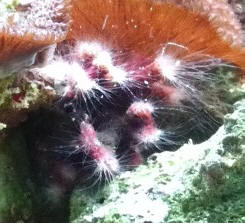 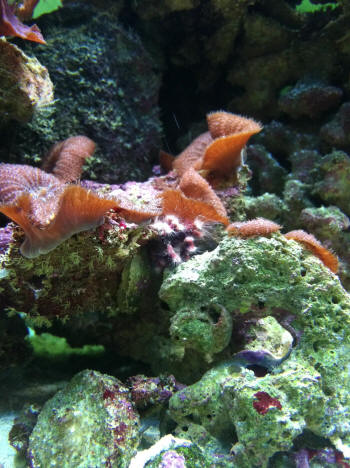 |
|
Need help with pick growth on rock: Probable
Foraminiferan – 3/10/12
Hello!
<Hello Amanda, Lynn here today!>
I'm trying to figure out what could possibly be growing on
one of my rocks.
<If it’s soft, it’s probably an alga of some sort.
If it’s hard/stony, then it’s more than likely a harmless,
beneficial, and very pretty Foraminiferan in one of three genera:
Homotrema, Miniacina, or Sporadotrema. All are in the
family: Homotrematidae and are found in tropical waters.
They’re also similar in color, in that they typically range
from shades of pink to reddish (sometimes a bit orange), can be
branching, and seem to prefer more protected areas away from
strong light. They feed by means of fine, hair-like structures
extending from the tips that collect particulate matter from the
water column. All in all, they make nice additions to a
system. For more information, please see the following
links:
See FAQ: “Unknown Pink Growth: Foraminiferan --
3/2/10”:
http://wetwebmedia.com/marprotozfaqs.htm
Homotrema rubrum/rubra:
http://www.foraminifera.eu/single.php?no=1000968&aktion=sucheMiniacina:
http://www.biolib.cz/en/taxonimage/id4217/Sporadotrema:
http://www.foraminifera.eu/single.php?no=1001903&aktion=suche
>
Thanks!
<You’re very welcome!>
Amanda Moore
<Take care, Lynn Z>
|
|
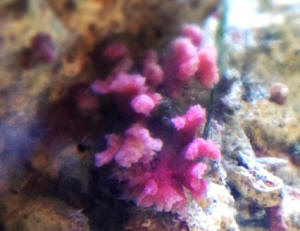
|
|
ID this thing ... - 2/9/11
Hi Crew member,
Attached are several pics of something from my tank. The bright
red ball appeared, stuck just under my RBTA.
Tank is a 72G Bowfront with a 30G sump/refugium, FL live rock,
DSB - running for about 1.5 yrs. Known inhabitants are mostly
common to the hobby - Scopas Tang, Niger Trigger, Blue Damsel,
Blueheaded Wrasse, Engineer Goby, (2) Clowns, Coral Banded
Shrimp, RBTA and a mix of Atlantic/Caribbean and Pacific corals
including SPS, LPS and softies.
The brightly colored fuchsia ball is about the size of a pencil
eraser, has a felt-like surface, sticks to the live rock, fish
won't touch it, seems to have a soft "shell" that
has split open. It doesn't appear to be porous
like a sponge ...but that was my first guess.
<Mine too.>
Any idea what the hell it could be?
<Are there any apparent openings (two, dissimilar in size) on
the surface?
If so my guess would turn to a sea squirt/Ascidian... At this
size this could be a Foraminiferan... http://wetwebmedia.com/marprotozfaqs.htm
Thanks for your thoughts.
David
<Do send along better resolved images if/when you can. Cheers,
Bob Fenner
|
|
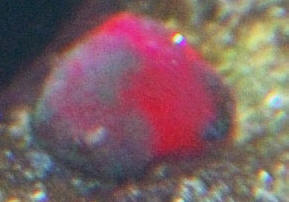
|
re: ID this thing ... - 2/9/11
Hi Bob,
Thx for the quick reply. And my eternal thx for access to your
wealth of knowledge! My Scopas will forever be in your debt.
<Welcome!>
Those are the best images I could get - no macro lens and a
bowfront tank (
the digital camera really struggles with angled shots and
focus).
<Ah yes. Am familiar>
It does not appear to have any well formed openings. The surface is
like dyed felt.
The casing-like structure could be a leathery shell or random
growth on the surface that was broken when the ??? grew a bit.
I looked up FORAMS HOMOTREMATIDAE and it is a possibility. Perhaps
in an early stage of growth - before branches form.
<Agreed>
For now, it has drifted away to some dark recess of the tank.
<I'd leave it be; enjoy it!>
David
<BobF> |
|
Help with ID of mystery coral 1/9/11
Greetings and Happy New Year Wet Web Crew!
<... groan... seven plus megs of pix... We ask folks to limit
these to a few hundred Kbytes>
I am hoping you might be able to ID a mystery coral (I will admit
to not being 100% sure about that, Heisenberg not withstanding)
that's been a delightful "hitchhiker" on some live
rock I purchased about three months ago. Unfortunately I do not
know where the live rock originated before it found its way to my
LFS.
There are a number of these creatures that can be found around
the system, but all are in shadowed areas, primarily on the
underside of rocks. They are perhaps 1/2 in length at this point
- it's hard to tell with all of them because they seem to
grow in crevices the depth of which is difficult to gauge.
The polyps/filaments are always extended. Day, night, doesn't
matter.
They are hard/rough to the touch (early on I thought it might be
a slime/red algae because there were no polyps visible. I was
glad to be wrong there!
I have searched the site (which is excellent!) as well as combed
through Borneman's book and have also tried a few Google
searches but nothing seems to fit. I've read descriptions of
both Tubastrea and Sponges that could fit, but have ruled out
sponges primarily because when the rocks were moved they were out
of the water for 10-15 minutes and growth continued. Tubastrea
seems unlikely as I am not feeding these poor things specifically
yet they appear to be thriving. We originally thought it might be
Montipora but now that it's large enough and extending those
long extensions, pretty sure that's not it either.
Please see the attached photos for details. Unfortunately it is
nearly impossible to get a good photo of the skeleton as its
polyps/extensions obscure them and, well, they're always out.
From watching the growth they do appear to share a base and
"branch" from there (there is another grouping in the
photos to the top/right that appears to be doing this), but there
are other growths like this that are singular (I believe you can
also see some of them in the photos to the top and right of the
larger grouping). Seriously, this stuff is all over. Only some of
it, however, thrives - those groupings that are in the
shadows.
Hoping someone has some idea what these are and if there's
anything I should be doing differently or even if I should be
very, very afraid of it. You never know...
Thanks very much in advance!
Lori
<Likely Ascidians... see very similar here:
http://www.wetwebmedia.com/AscidIDF4.htm
Bob Fenner>
|
|
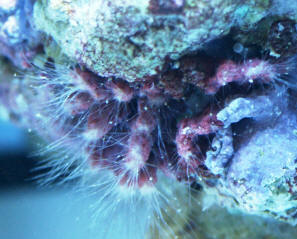
|
|
Re Hydroid? Cnidaria? Sponge? Our mystery guest is...
1/24/11
Greetings Wet Web Crew!
<Hello again Lori!>
I had written a couple of weeks ago but others have had issues
with my e-mail and given I included several very large hi-res
photos, well, never hurts to ask. Because I know you can't
possibly be busy updating the site or answering other queries or
doing other productive things (like jobs and stuff). :-)
<Oh yes>
In any case, I've continued researching while I waited and am
now even more confused than ever. I've uploaded as hi-res a
photo to Flickr as I can for your viewing pleasure:
http://www.flickr.com/photos/58719687@N04/5385512862/
Descriptions and other IDs on the site here seem to indicate it
could be a Hydroid.
<Mmm, yes. I had replied to this query>
Or a Hydrozoan. Or perhaps a Sponge or maybe some strange
communal relationship between one or more in some sort of
twisted, undersea love triangle. Or maybe it's a coral of
some sort? That'd be awesome but my day has been going such
that I would not expect that to be the case. A photo in
http://www.wetwebmedia.com/AscidIDF4.htm seems eerily similar,
though the body of these and formations appear foliate and
digitate in nature, though it's hard to tell whether the
foliate forms are simply two or more fingers in a colony growing
very closely together. Your answer to the query referenced in the
FAQ above, by the way, pointed at Hydroid/Hydrozoans but after
reading those FAQs this does not seem to be the case? Of course
I'm not the expert, which is why I'm writing you.
<I do think what you have pictured is both Ascidian AND
Hydroid... the "feathery bits">
The branches are firm. When they first appeared a few months ago
I feared Cyano or slime algae, so I brushed at them and they did
not give at all - they were actually fairly rough to the touch.
So I continued watching. The rocks upon which they were growing
were moved - and thus exposed to air - about a month ago to a
150g tank, which at first disabused me of the notion they were
sponges but then again with the new arrangement these could be
different growths.
The extensions appear quite rigid in the photo but close
observations shows them to be more flexible, more like a polyp or
tentacle than a rigid extension. There are many, many of these
growths, but only ones growing downward in shadows on the
underside of rocks or in crevices exhibit rapid growth and these
extensions. Those in the photo have grown about 3/4" in the
past month to extend out of the crevice they are in.
I'm running 1 14,000K HQI metal halide (150 watts) and 4 (39
watts) HO T5 actinics.
Any thoughts are greatly appreciated - they are interesting to
see growing but if they're dangerous I'd rather remove
them before they turn into a plague. I do have higher resolution
photos but am reluctant to attach in case that's keeping my
e-mail from being delivered. If you received my first e-mail but
haven't had a chance yet to respond, my apologies. If you did
respond and I didn't receive (which has also happened in the
past month or so, or so I'm told) my apologies.
<See here: http://wetwebmedia.com/NonvertIDF56.htm
dated 1/9>
I'd buy you a beer to make up for it but I'm not
traveling much these days. :-(
<If you're close by, I'll drive on over!>
Thanks for the great site and all the great information!
Lori MacVittie
<Welcome! Bob Fenner>
re: Hydroid? Cnidaria? Sponge? Our mystery guest is...
1/24/11
Ah, thank you very much for re-responding and my apologies about
the size of the original photos. Will keep to minimum or use
Flickr in the future.
<Ah, thank you>
Now I just need to figure out what happened to your
response...hmmm...
<Yikes! Am not a high-tech kind of guy>
Many thanks!!
Lori
<As many welcomes. BobF>
Update: Is the mystery guest really Sporadotrema?
Foram.! 2/6/11
Greetings (again)!
<Lor>
I have good news and an update/question regarding the
"mystery guest".
<Oh!>
The good news is I discovered you were caught in the big
technology QT in the sky. My SPAM filtering service has been
updated and unlike my system your e-mail will go straight to the
DT.
<Ah, good>
You (well, perhaps not "you" per se but BobF unless
this is BobF and then "you" really does mean
"you") had suggested my mystery guest was both Ascidian
and hydroid. I was reading about pods (because I found tons of
them in both my systems - wheeeee!) and followed a link that led
me here and there and then to this image:
http://www.nevillecoleman.com.au/gallery/image-listing.aspx?ImgGroupId=7839
<Mmm, could be!>
That certainly appears to be the same critter as in my photo. A
Foraminiferan identified by the image as "Sporadotrema
meserfericum".
I'm fairly certain of the id based on the photo match - even
the test appears the same as described, especially as
occasionally I can see particulates caught in it that eventually
disappear. I did a search on WMM and did not find any further
information on Sporadotrema but did find more on Homotrema
rubrum. Interestingly the photo around which the discussion of
Homotrema is based (here: http://www.wetwebmedia.com/lridfaq7.htm)
looks a lot more like the one in the aforementioned link/image
that describes it as Sporadotrema.
<Agreed>
Now I've been trying to read about forams (which is
fascinating and has led to the ID of some of the other growth
forms in my system which appear to be Homotrema rubrum) but
I'm not finding much about Sporadotrema except in lengthy
very scientific journals that are more confusing than anything
else. For the most part I gather these are (a) not dangerous, (b)
not toxic, and (c) require very little attention on my part. Do
you concur with this conclusion? Is there something else of which
I should be aware?
<I do concur w/ these statements. Not harmful esp.>
If I'm reading things correctly they're both
Foraminiferans so it shouldn't really matter but now I'm
curious (and a little excited to perhaps have found an answer to
the question "what are those 'bearded things'
growing in the system??").
<I do (still) think these are another organism. Do you have
access to a dissection 'scope?>
Thanks in advance (for wading through this message and for all
the great information you provide!)
Lori
Thoughts?
<Do please read here: http://wetwebmedia.com/marprotozfaqs.htm
Lynn's ID et al. re Forams. BobF>
|
|
Sea Grape 4/17/10
Hi Bob, Lynn,
<Neale>
I wonder if you know what this object is. A friend found several
of them on a beach in Florida. As you can see, they're about
the size of a penny. They are grainy like rough paper, slightly
glossy, and with a hole at one end.
They look a bit like the cells of burrowing wasps to me, but I
don't think that's the case of they were found on a
beach. Any ideas?
Cheers, Neale
<Mmm, my best guess w/ these pix, descriptions is that these
are Foraminiferan skeletons. Lynn? BobF>
Re: Sea Grape 4/17/10
Thank you Bob. I'd considered that idea too, e.g., Gromia
spp., but thought these specimens were perhaps rather too large
for inshore Forams.
Cheers, Neale
<Might/could have been transported from deeper water... air
filled w/ decomposition of other life that had come to reside
w/in. BobF>
|
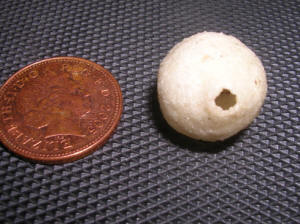 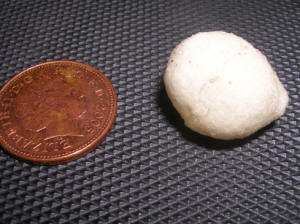 |
|
Sea Grape, Lynn's go 4/17/2010
<Hi Bob, Neale>
I wonder if you know what this object is. A friend found several
of them on a beach in Florida. As you can see, they're about
the size of a penny. They are grainy like rough paper, slightly
glossy, and with a hole at one end. They look a bit like the
cells of burrowing wasps to me, but I don't think that's
the case of they were found on a beach. Any ideas?
<The first thing it reminded me of was a praying mantis egg
case:
http://2.bp.blogspot.com/_lDfVXMCBuu0/STthPwvtTkI/AAAAAAAACBA/NPcU2zgD-fg/s1600-h/praying+mantis+egg+sacs.jpg
or a wasp gall, but it could be something like a bleached Prickly
Palm nut (Acrocomia spp.). They vary in size, can range in color
from black to bleached white and have a rough texture (before
polishing). There's a whole group of people that collect all
sorts of "sea beans" on beaches. I have a few myself,
but have never seen anything like this. Here are a few examples
(some have been polished):
Prickly Palm nuts spread across upper left area (note the white
one):
http://1.bp.blogspot.com/_uuHPvedMUw4/SwiON_fvX_I/AAAAAAAA
CzM/WyFhO88s5hA/s1600/IMG_0209.jpg
Here's a before/after (polishing) of a Prickly Palm nut:
http://1.bp.blogspot.com/_uuHPvedMUw4/SRdJ9iTRl9I/AAAAAAAA
BhY/0n49DBITJ70/s1600-h/IMG_0239.jpg
If I had to guess, I'd say it's a Prickly Palm nut. If
not, my next guess would be some sort of deserted, combination
mucus/sand burrow, or subsurface egg chamber made by what I
don't know, that was exposed at some point. I don't
remember the sand in Florida being that white but it's been a
while since I was there. Hope that helps! Take care, Lynn>
Cheers, Neale
Hello Lynn,
The sea grape doesn't have the three-fold radial symmetry of
the palm nut, and is far too thin and light anyway, so I
don't think that's right. But your idea of some sort of
hardened burrow makes sense. Dried mucous would give the
glossiness I'm seeing, and it could easily be stuck together
from sand. What sorts of animals lay eggs in subsurface
burrows?
Cheers, Neale
|
Unknown Pink Growth: Foraminiferan --
3/2/10
Hi all!
<Hey Debbie, Lynn here today!>
When I designed my acrylic 35 gallon SPS tank, I had a 10 gallon
refugium set up to be next to it as a display refugium. I used pond
foam to create a sort of dark cave for the Rusty goby and
peppermint shrimp that I put in there along with some rubble,
hitchhiker bivalves, sponges and the like. This section gets no
light except for ambient room light and you still need a flashlight
to see in it. I had sun corals in there, also, but moved them, as
you can see there's a baby that got left behind.
<Yep, I see it.>
Several months ago I noticed this pink growth around one of the
bivalves. It was so small I couldn't get a good picture to send
in for identification. About two weeks ago all the tips were
covered in a white spongy material and I thought some sponge had
managed to start growing on it. However, after a few days the
"white stuff" seemed to just disintegrate and the coral
appeared just fine. But now I've started noticing these
pink/red spots like the one under the word "New" that are
starting to grow. I've counted about 40 that I can see. A
couple are by the front and they have the same type of tentacles as
the main colony. They're about the size of a pinhead. The main
colony in the picture is only about 3/4 of an inch wide so it's
quite small.
<Looks like you've got a nice little Foraminiferan colony!
Forams are harmless, filter-feeding Protozoans that come in all
shapes and sizes. From the looks of things, you have a common,
stationary, branching variety called Homotrema rubrum. The pink
coloration and presence of fine filaments (aka rhizopodia -- used
for feeding) extending from the tips are distinctive.>
The tips have thin strand-like tentacles and I attached a close-up
picture of those as well.
<Nice photo showing the rhizopodia! One thing I see that may not
be a Foram is the small, darker object between the two light pink
Foram tips. The fact that it appears so shiny and smooth makes me
think it's an Ascidian/Tunicate, but it could just be a smaller
Foram. Color can vary with these. If you get a close look at it and
see rhizopodia, then it's definitely a Foram. Tunicates
don't have those.>
I'm unable to reach it, so I can't tell if it's spongy
or hard, although the tubes appear to be hard just by looking at
them.
<Yep, they're hard/stony-feeling.>
I'm hoping that by chance somebody may have come across
something like this and knows what this is.
<Oh yes indeed. I've had these in my tanks for years and
love 'em!>
I'm stoked that it spawned in my tank so I'll be
documenting their growth. Any information or insight would be
great.
<This link should be helpful:
http://reefkeeping.com/issues/2003-07/rs/index.php
Be sure to Google WWM also, as there have been several references
to these over the years:
http://www.wetwebmedia.com/Googlesearch.htm >
Thanks!
<You're welcome!>
Debbie
<Take care, LynnZ> |
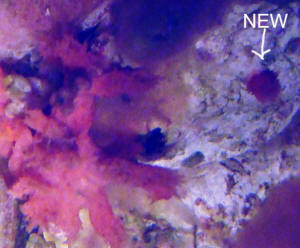 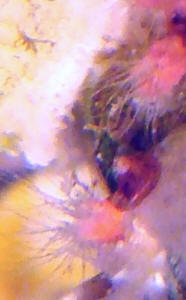 |
| Is this Velvet or Crypt, and what are these white
things 1/4/08 Hello. <Greetings Joe> Thanks for all
the helpful information that you provide. I have spent dozens of
hours reading on your site, and yet I know that I have so much left
to discover and learn. <As do we all> I have a 120 G
saltwater Fish only tank in which there was a massive die off all
within a week period from first signs (cloudy eyes, breathing
difficulty, death). I attributed the deaths to /Amyloodinium
ocellatum / due to the rapid onset and a few white "dots"
that appeared on the fish/. / The first picture (100 X Mag) is from
gill scrapes taken and are representative of what was found. Can
you confirm these as either /Cryptocaryon irritans or
//Amyloodinium ocellatum? <They do very much look like trophonts
of Amyloodinium... do you have Iodine that you might test them for
staining?> /All but the initial fish that helped cycle the tank
were aggressively quarantined with Chloroquine and rotated with QT
tank change every 3 days for four changes, but as I have sadly
learned, any fish can introduce disease into the tank. <Yes,
actually, anything wet> |
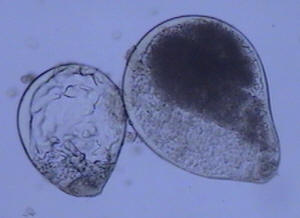 Amyloodinium trophonts Amyloodinium trophonts |
| The Main tank was left without fish for 11 weeks. 4 weeks into
the fallow period, I began seeing small white dots, about 1/10 mm
in size forming on the green algae on the glass, and where they
would appear, the algae would disappear in an expanding circle of
small white dots. <Yes... I see... what appear to be a small
snail, but could be a Foraminiferan... or...> The second picture
is an microscopic picture of one of these. These are not moving on
the glass, and much smaller than copepods which are moving on the
glass. |
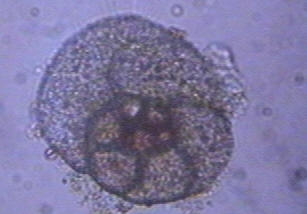 Foram most
likely Foram most
likely |
In the midst of the smaller dots, there are also larger, about
1 mm in size cream/white/tan colored dots that as can be seen in
the final picture taken of the glass sides of the tank. These are
slowly moving on the glass and removing/eating the algae as they
pass as demonstrated on the picture. Under the microscope, the
larger dots appear to be larger versions of the smaller ones, too
dense and dark to photograph well. Is there any chance that these
are the developing tomonts of /Cryptocaryon irritans or
//Amyloodinium ocellatum/ left from when the outbreak occurred?
<Mmm, not on the glass, moving, no... Is some other form of
life.> Are these something I need to be concerned about? <Not
the stuff other than the Amyloodinium, no> Thank you for your
help as I work thought the process of getting my tank healthy
again. Joe
<Nice pix Joe. Thank you for sharing. Bob Fenner> |
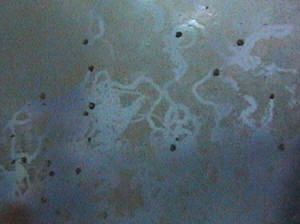 Got me... Got me... |
|
Foraminiferans Irritating Corals? 11/21/2008
Hello to whomever is answering emails today :D <Hi Miguel,
Mich here.> I've been having an issue with what I think
are Marginopora vertebralis, which I just Id'd thanks to the
handy search function on your site. <Looks to be so.> For a
back story, I've had issues in the last few months with LPS
peeling slowly, and every time on the peeling flesh I find these
Foraminiferans. It seems like they're slowly irritating the
corals to death as they feed on whatever it is that they're
feeding on the live rock. <Mmm, does not necessarily make it
causational.> I've included a picture of what I think is
them irritating a coral. <In researching I have not found
information to support this, but that does not mean it is not
possible.> This is how all of the peeling LPS tissue in my
tank looks like, you can see that at 12 and 6 o'clock they
are digging into the flesh of the coral, and especially at 5
o'clock you can see a smaller one digging into the coral with
a distinct peeling flesh next to it. <This is unusual.> At
the very bottom right of the image you can see them working into
the flesh as well, and in the top left there is a white spot on
the coral that's actually another one that has just attached.
<I see.> I'm not sure if these are the cause of the
problem or just bystanders in another tank issue that may be
going on, but it's a bit coincidental that they're always
right at the edges of the peeling sides of the corals. <Some
types of Foraminiferans feed on bacteria, perhaps the
Foraminiferans are feeding on areas of decay.> One of my
friends had a microscope, so I'm attaching several highly
magnified images in order of magnification. <Cool!> They
average about 1mm across, and in picture 4 there is a blob of
green. <I see.> I'm not sure what that is but it's
the only block in the Foraminiferan that had one in there,
possibly it's feeding on it? <Is a possibility.> Thanks
very much for your time, and I hope things are well! <Thank
you Miguel.> Miguel <Cheers, Mich>
|
|
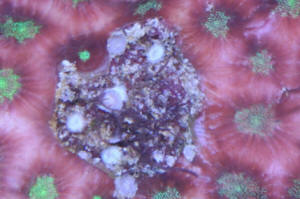

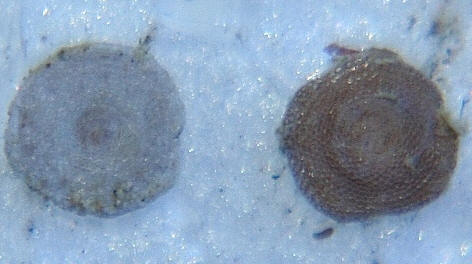 Nice pix! RMF Nice pix! RMF
|
|
Looks like a UFO, but it's a Foraminiferan!
- 1/23/08 Hi Guys! <Hi there, Terje!> Can you help me
identify this brown thing? The picture should be approximately
1:1 (on a 15-19" monitor :) ) = 3mm. <<ufo.jpg>>
<Wow! Looks like a very pretty little Foraminiferan test.
Forams are harmless, single celled organisms
("Protists") that are shelled and supposedly feed on
bacteria and organic matter. Please see these links for photos
and more information re:
http://home2.pacific.net.ph/~sweetyummy42/hitchodds.html
http://www.reefkeeping.com/issues/2003-07/rs/index.php >
Regards
Terje Midtb?
<Take care -Lynn>
|
|

|
|
|

